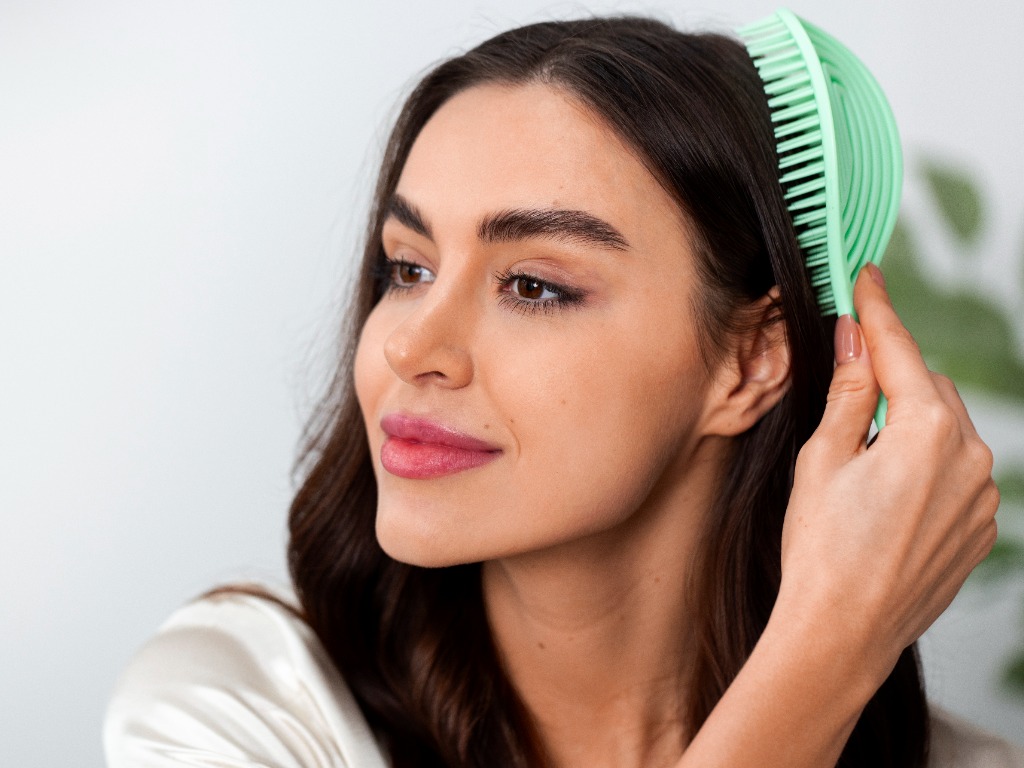Ever wondered why your hair seems to behave differently when it’s wet? It’s all about the science!
Hair Structure and Water
Our hair is made up of tiny strands called fibers. These fibers are composed of a protein called keratin, which gives our hair its strength and structure. When we get our hair wet, the water molecules penetrate the outer layer of the hair, known as the cuticle. This can cause the cuticle to swell, making the hair more susceptible to damage.
The Role of Hydrogen Bonds
Another important factor is the presence of hydrogen bonds within the hair’s structure. These bonds help to hold the hair strands together, giving them their shape. When water molecules interact with these hydrogen bonds, they can temporarily weaken them, making the hair more adaptable.
The Bottom Line
So, while water can make our hair more manageable, it’s significant to be gentle and avoid excessive combing or brushing, as this can lead to breakage and damage. Understanding the science behind wet hair can help us take better care of our locks and achieve healthier, stronger hair.
The Pros and Cons of Combing Wet Hair
Combing wet hair can be a double-edged sword. While it can offer certain benefits, it’s also significant to be aware of the potential drawbacks.
Pros:
- Easier to detangle: Wet hair is generally more pliable than dry hair, making it easier to detangle and prevent breakage.
- Temporary straightening: Combing wet hair can help to reduce frizz and create a straighter appearance, especially for those with naturally wavy or curly hair.
Cons:
- Risk of breakage: If not done carefully, combing wet hair can lead to breakage, especially for those with damaged or fragile hair.
- May promote frizz: Excessive combing can disrupt the hair’s natural oils, leading to frizz and dryness.
- Can affect hair texture over time: Repeatedly combing wet hair can gradually change its texture, making it more prone to frizz or breakage.
It’s important to strike a balance between detangling your hair and avoiding excessive combing.
Best Practices for Combing Wet Hair
If you’re looking to minimize damage and maintain healthy hair, here are some best practices for combing wet hair:
- Use a wide-tooth comb: This helps to gently detangle hair without causing excessive breakage.
- Apply conditioner or leave-in conditioner: These products help to soften and protect the hair, making it easier to comb and reducing frizz.
- Comb gently from ends to roots: Starting at the ends helps to prevent breakage and works gradually towards the roots.
- Avoid excessive brushing: Brushing too often can damage the hair and contribute to frizz.
By following these tips, you can help to keep your hair healthy and looking its best.
Alternative Methods for Straightening Hair
While combing wet hair can help to temporarily straighten it, there are other methods you can try for a more lasting effect:
- Heat styling: Blow dryers, flat irons, and straightening irons are popular options for achieving straight hair. However, excessive heat can damage the hair, so it’s significant to use heat protectants and minimize exposure.
- Chemical treatments: Relaxers and keratin treatments can provide long-lasting straightness, but they can also be harsh on the hair and require professional application.
- Natural methods: Air drying, braiding, and twisting can help to straighten hair naturally without the use of heat or chemicals.
The best method for you will depend on your hair type, desired results, and personal preferences. Experiment with different techniques to find what works best for you.
Tips for Maintaining Straight Hair
Once you’ve achieved straight hair, it’s important to take steps to maintain its appearance. Here are some tips:
- Regular trims: Regular trims help to remove split ends and prevent further damage, promoting healthier-looking hair.
- Deep conditioning treatments: Deep conditioning treatments can nourish and hydrate the hair, improving its overall health and appearance.
- Protecting hair from heat damage: Use heat protectants and minimize heat styling whenever possible to prevent damage and maintain straightness.
- Using the right products: Choose products specifically formulated for straight hair to help maintain its texture and reduce frizz.
By following these tips, you can help to keep your hair looking its best and maintain a straight style.
Conclusion
In conclusion, while combing wet hair can be a helpful tool for detangling and achieving a temporary straight appearance, it’s significant to be mindful of the potential risks. By following best practices, using alternative methods, and maintaining a healthy hair care routine, you can achieve and maintain straight hair without compromising its health.
FAQ Section
Is it better to comb wet hair or dry hair?
While both have their pros and cons, combing wet hair can be more gentle and help to detangle without causing excessive breakage.
Can combing wet hair make it curlier?
No, combing wet hair will not make it curlier. However, if your hair has natural waves or curls, combing it wet can help to enhance its natural texture.
What is the best way to comb wet hair with extensions?
Be extra gentle when combing wet hair with extensions to avoid pulling or damaging them. Use a wide-tooth comb and start at the ends.
How often should I comb my wet hair?
You should comb your wet hair as needed to detangle it. Avoid excessive combing, as it can damage the hair.
Can combing wet hair cause hair loss?
While excessive combing can contribute to hair breakage, it is unlikely to cause significant hair loss. If you’re experiencing excessive hair loss, it’s best to consult with a dermatologist.



4 Comments
Real clear website , thanks for this post.
https://www.gorillasafariscompany.com/
he blog was how do i say it… relevant, finally something that helped me. Thanks
https://www.zoritolerimol.com
4zchni
r8gfr6